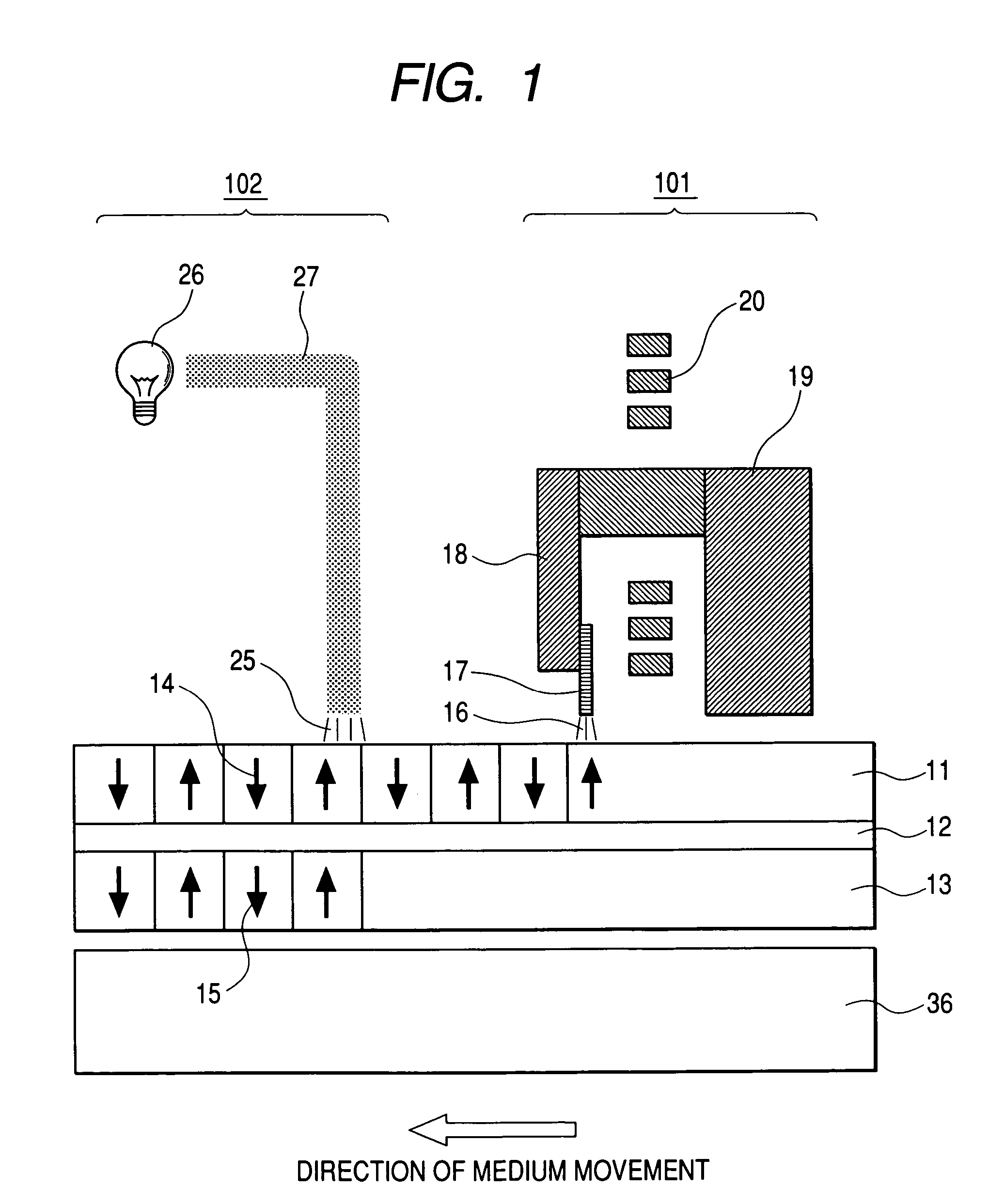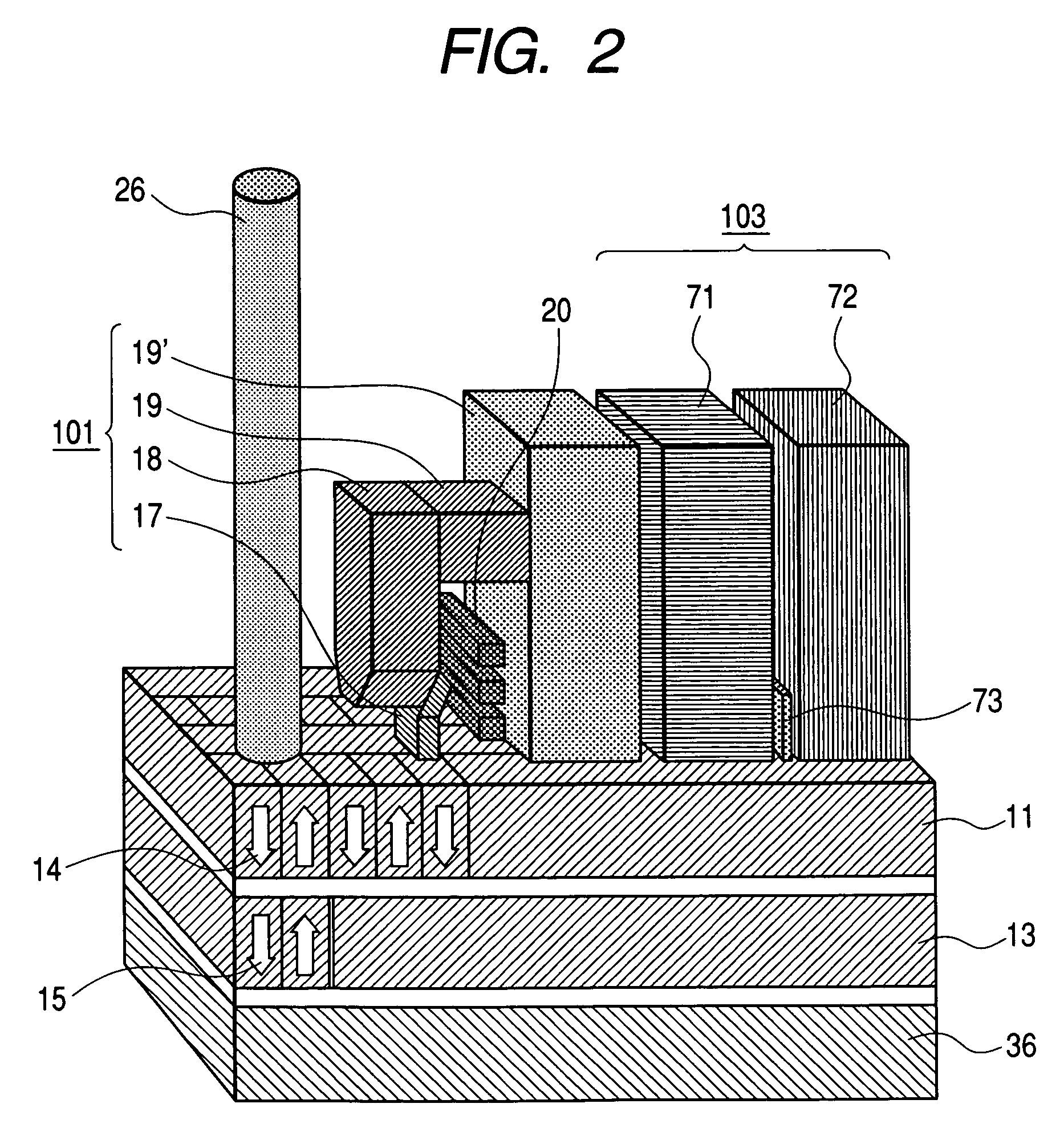Magneto-optical recording using a heating element
a heating element and magnetic recording technology, applied in the field of magnetic recording methods, can solve problems such as the difficulty of mounting magnetic field generation means, and achieve the effects of easy integration of magnetic heads, small and thin magnetic disk recording apparatuses
- Summary
- Abstract
- Description
- Claims
- Application Information
AI Technical Summary
Benefits of technology
Problems solved by technology
Method used
Image
Examples
example 1
[0072]FIG. 1 is a schematic diagram of a magnetic recording system embodying the present invention. A reproducing device is omitted. FIG. 2 shows a perspective view of the same system to which the reproducing device is added.
[0073]A magnetic recording device 101 has a magnetic pole 17 generating a recording field 16, a yoke 18 for supplying a magnetic flux thereto, a return path 19, and a conductor coil 20 for magnetizing these. Heating means 102 has a laser light source 26 and a waveguide 27. A semiconductor laser generating a light having a wavelength below 500 nm is desirably used as the laser light source 27.
[0074]The magnetic recording device 101 and a flux keeper layer 36 form a magnetic path in which a magnetic flux is refluxed. A magnetic recording medium is interposed therein. The recording field 16 from the magnetic pole 17 toward the flux keeper layer 36, that is, a magnetic field substantially perpendicular to the surface of the magnetic recording medium is applied.
[0075...
example 2
[0097]FIG. 7 is a perspective view showing the state during an overwrite operation which is an operation writing new recorded data onto old recorded data in the magnetic recording system for thermo-magnetic printing applying the present invention.
[0098]After forming a pattern on the first recording layer by a magnetic field from the magnetic pole 17, noting the state before heating-up it by the heating means, the magnetization pattern of the first recording layer 11 is different from the magnetization pattern of the second recording layer 13. Depending on a location in which the recording pattern is formed, a magnetostatic field from the magnetization pattern of the second recording layer 13 may deteriorate the magnetization of the first recording layer 11.
[0099]This means that the pattern of old recorded data interferes with new recorded data, which deteriorates the overwrite characteristic as the recording characteristic. To prevent the interference, it is essential to form the in...
example 3
[0104]FIG. 9 is a cross-sectional view of a magnetic recording medium used in a third example. The second recording layer of the magnetic recording medium in the third example has a three-layered structure of upper ferromagnetic layer 13a / anti-parallel coupling layer 32 / lower ferromagnetic layer 13b. As the upper ferromagnetic layer 13a, there is selected a material whose saturation magnetization at low temperature is smaller than that of the lower ferromagnetic layer 136b and in which a Curie temperature at which magnetization disappears is high. Ru, Rh, Cr and Ir are used as the anti-parallel coupling layer 32 to couple the magnetization patterns of the upper and lower ferromagnetic layers to be always anti-parallel.
[0105]FIG. 10 is a characteristic diagram showing temperature dependence of saturation magnetizations of the upper and lower ferromagnetic layers and a characteristic diagram showing temperature dependence of saturation magnetization of the second recording layer havin...
PUM
| Property | Measurement | Unit |
|---|---|---|
| thickness | aaaaa | aaaaa |
| thickness | aaaaa | aaaaa |
| thickness | aaaaa | aaaaa |
Abstract
Description
Claims
Application Information
 Login to View More
Login to View More - R&D
- Intellectual Property
- Life Sciences
- Materials
- Tech Scout
- Unparalleled Data Quality
- Higher Quality Content
- 60% Fewer Hallucinations
Browse by: Latest US Patents, China's latest patents, Technical Efficacy Thesaurus, Application Domain, Technology Topic, Popular Technical Reports.
© 2025 PatSnap. All rights reserved.Legal|Privacy policy|Modern Slavery Act Transparency Statement|Sitemap|About US| Contact US: help@patsnap.com



